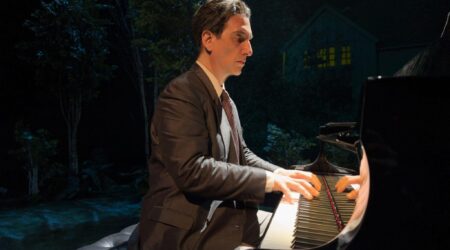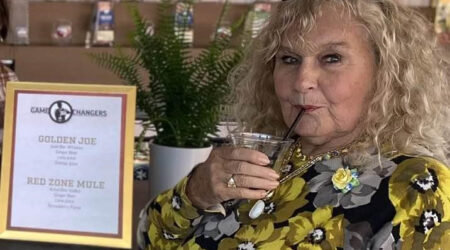More Pliable Than Steel
The San Francisco I knew when I was growing up had an abandoned hospital tucked in the Presidio. In junior high, my then best friend, Luke and I had a morbid fascination with it, if for no other reason than it looked like a pretty creepy trip. After school at his house, after I finished […]
The San Francisco I knew when I was growing up had an abandoned hospital tucked in the Presidio. In junior high, my then best friend, Luke and I had a morbid fascination with it, if for no other reason than it looked like a pretty creepy trip. After school at his house, after I finished my homework and he finished ignoring his, we’d spend hours online, trying to dig up facts, stories, rumors, and supposed “haunted” photographs of the place, occasionally fantasizing out loud about the possibilities, just to see who would freak out first. (It was always me – I always came home and went to bed with sephia-toned nightmares afterward – but Luke never knew it.)
The way it looks in my memories, it’s almost majestic , straight out of a B-movie horror flick: massive walls, haphazard barbed-wire fence, and laughably easy to sneak into. I did, many times, with Luke and his older brother, Kelly and Kelly’s high school friends, two cars of us piled on top of each other driving through the Richmond, me the token girl with the long pink hair and atrocious eye-liner in generous amounts who never said much. I had my first real, this-is-not-Mike’s-Hard-Lemonade drink there: a giant thing of Malibu that one of the guys brought and which we passed back and forth on the first night we went there. I don’t know why we kept coming back. But because hindsight is 20/20, or so they always say, I know now that that night was an initiation of sorts for me. It seems that in the weeks immediately preceding that night there was still a bit of the old me left – the girl who wore thick, gold-rimmed glasses with Bugs Bunny on either side of the frames, long hair in pig-tails, lips turned up into an awkward, hesitant smile. It felt liberating, after being uncleverly dubbed “Nerd Girl” and being ignored, to lace up combat boots over a pair of black jeans and shrug on a two-sizes-too-large leather jacket over a cut-up and reconstructed band t-shirt – to embrace being on the outside and having completely by-passed being ignored, because how can you ignore something you don’t notice to begin with? But on that night, I was suddenly committed; these weren’t just abstract escape tactics anymore, now they made up the details of who I was, of the life I lived. I was 12, going on 13 – no one ever predicted it would happen so early, or at all, for me. My walls came up, my mouth slammed shut, and I resigned myself to simply taking everything in with a hardened mask of a poker face – perpetually unimpressed while inside my thoughts were whirring. I had a voice and I tuned it out, only used it to fill-up journals from cover-to-cover, but never to say anything out loud, for fear of revealing too much.
 I had one catch-phrase that I muttered whenever something hurtful happened. I’d knock on my chest lightly with my knuckles, smirk and wink, then say with practiced nonchalance, “Made of steel, man.” And I could fool anyone, even myself.
I had one catch-phrase that I muttered whenever something hurtful happened. I’d knock on my chest lightly with my knuckles, smirk and wink, then say with practiced nonchalance, “Made of steel, man.” And I could fool anyone, even myself.
Auden Sletten, Per Petterson’s adolescent protagonist , had his own catch-phrase (which, coincidentally, also happens to be the book’s title): “It’s fine by me.”
Whenever his father stumbles home drunk, when this father gives in to violent urges, when he and his family move away in an attempt to escape, when his brother drowns, when his sister moves out, when he quits school to work, when the work isn’t working, when he catches sight of his father again, and when everything culminates into an event both unexpected and entirely appropriate – “It’s fine by me,” Auden says with a shrug.
He is a character we either have been (as I have been), or have known, to some degree. He is eccentric, toughened, secretly insecure, smart and well-versed both in school and in life, impressionable when it comes to his literary heroes, but self-aware enough to know that he is not as rebellious as he makes himself out to be. Auden knows all too well that the distinction between a truth and a lie are blurred, but he nevertheless prides himself on sincerity. On his first day of seventh grade in a new school, Auden slinks into the classroom in a pair of sunglasses and, when asked to take them off, coolly mumbles, “I can’t. I have scars.” It is a lie, yes, because he doesn’t have scars – but all too true when you consider that the existence of non-physical ones. He is, in short, that boy on the fringes with good intentions, quietly trying to form an identity in the midst of grappling with harsher realities. But where Petterson could have dropped the ball entirely and resigned Auden to a caricature of a teenage “rebel without a cause,” he manages to capture – with the same subtle yet poignant sleight of hand and keen attention to his character’s emotional life – the presence of soulful hope and ambitious potential, and more importantly, in the end, a beautiful and raw vulnerability in Auden.
It’s Fine by Me is not a book about a teenager coming out of a phase, or a book about a troubled boy and his troubled relationship with his father. It’s a book about, simply, coming to terms with the person living beneath your skin – the mask it wears and the intricacies underneath – and accepting that the past had to be how it was to give you everything you need to propel yourself into the future.
During one of my many visits to the abandoned hospital in the Presidio, I managed to pen the following lines onto the final pages of a composition notebook, bindings torn, cover suspiciously halved:
Sometimes, I’m pretty sure I only do the things I do to test if anyone would notice enough to stop me. The only thing worse than doing something as a cry for help, is being self-aware enough to know that it’s a cry for help, a pathetic and unnecessary cry for help – but doing it anyway, because you don’t have the guts to just ask.
Here’s what I know today, right now:
I’ve made terrible decisions, have done terrible things, and have hurt good people. I’m not made of steel, but of something more pliable and I’m glad, because it means I have to capacity for self-recognition, and the will to atone for them. Auden and myself, I believe we illustrate a deeper truth once penned by one Mr. J. R. R. Tolkien:
“Not all those who wander are lost.”
By Jayne Wilson
Jayne Wilson writes fiction about the likes of decapitated gnomes, compulsive hoarders, and sardonic old men. She laughs pathetically at her own jokes and is generally an impish mess. She graduated from the University of California, Davis in 2010 with a degree in English-Creative Writing.
/emp align=”center”





